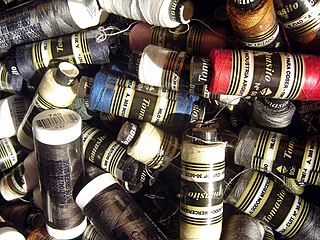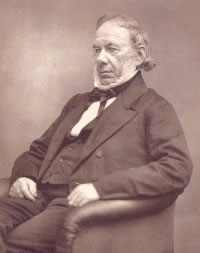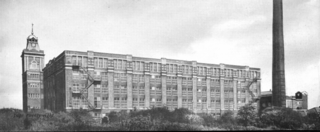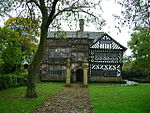
Mercerisation is a textile finishing treatment for cellulose fabric and yarn, mainly cotton and flax, which improves dye uptake and tear strength, reduces fabric shrinkage, and imparts a silk-like luster.

Textile manufacturing or textile engineering is a major industry. It is largely based on the conversion of fibre into yarn, then yarn into fabric. These are then dyed or printed, fabricated into cloth which is then converted into useful goods such as clothing, household items, upholstery and various industrial products.

Breightmet is a neighbourhood of Bolton, in Greater Manchester, England. The population of the ward taken at the 2011 census was 13,584. Historically a township of the civil and ecclesiastical parish of Bolton le Moors in the Salford hundred of Lancashire, it lies 2 miles (3.2 km) north-east of Bolton and 4 miles (6.4 km) north-west of Bury.

John Mercer was an English dye and fabric chemist and fabric printer born in Great Harwood, Lancashire. In 1844 he developed a process for treating cotton, mercerisation, that improves many of its qualities for use in fabrics.

In textile manufacturing, finishing refers to the processes that convert the woven or knitted cloth into a usable material and more specifically to any process performed after dyeing the yarn or fabric to improve the look, performance, or "hand" (feel) of the finish textile or clothing. The precise meaning depends on context.

Bolton Union Mill was a cotton spinning mill in Halliwell, Bolton, Greater Manchester. It was built in 1875 and 1880. It was taken over by the Lancashire Cotton Corporation in the 1930s and brought back into production. Subsequently, it passed to Tootals and Dewhurst Dent in 1964. Production finished in 1967.

Century Mill, Farnworth is a former cotton spinning mill in Farnworth, Bolton, Greater Manchester, England which was built in the early 20th century for ring spinning. It was taken over by the Lancashire Cotton Corporation in the 1930s and passed to Courtaulds in 1964. The 6,674.00-square-metre (71,838.3 sq ft) building is still in use for various other purposes in 2016.

Fox Mill was a cotton spinning mill in Hollinwood, Oldham, Greater Manchester, England. It was taken over by the Lancashire Cotton Corporation in the 1930s and passed to Courtaulds in 1964.

Wilton Mill, Radcliffe was a cotton spinning mill in Radcliffe, Bury, Greater Manchester. It was built in 1907 and was taken over by the Lancashire Cotton Corporation in 1930 and passed to Courtaulds in 1964. Production finished in 1965, after which it was used by the East Lancashire Paper Company but has now been demolished leaving an empty site next to the railways and the River Irwell.

Royton Ring Mill was a cotton mill in Royton, Greater Manchester, England. It was built in 1908 and extended in 1912. It was taken over by the Lancashire Cotton Corporation in 1935 and passed to Courtaulds in 1964. Production finished in 1966. It was extended again in 1969 and used for other purposes. It has now been demolished, the street has been renamed and houses have replaced it.

May Mill was a cotton spinning mill in Pemberton, Wigan, Greater Manchester, England. Historically in Lancashire, it was built in 1889. It was taken over by the Lancashire Cotton Corporation in the 1930s and passed to Courtaulds in 1962–63 to produce carpet fibre, which it continued to do until its closure on 17 October 1980.

Pilot Mill, Bury is a four-storey cotton spinning mill in Bury, Greater Manchester, England. It was built in 1905 for the Pilot Spinning Co. It was taken over by the Lancashire Cotton Corporation in 1939. The mill closed in 1962 and was later sold to Antler Luggage. The Mill is currently occupied by Baum Trading Ltd and Metzuyan Ltd they have opened a retail outlet with an on site cafe.

Elm Mill, was a four-storey cotton spinning mill in Shaw and Crompton, Greater Manchester, England. It was built in 1890 for the Elm Spinning Company Ltd., and was called Elm Mill until it closed in 1928. It was revived by the Lancashire Cotton Corporation in 1929 and called Newby Mill. LCC and all their assets passed to Courtaulds in 1964. Production at Newby finished in 1970, and it was used for warehousing. Subsequently, named Shaw No 3 Mill, it became part of Littlewood's Shaw National Distribution Centre. It was demolished to make way for housing in 2022.

Orme Mill, Waterhead is a cotton spinning mill in Waterhead, Oldham, Greater Manchester, England. It was built in 1908. It was taken over by the Lancashire Cotton Corporation in the 1930s and production finished in 1960. The mill was passed on to Ferranti in 1964, and is now in multiple usage.

Elder Mill, Romiley was a cotton spinning mill in Romiley, Stockport, Greater Manchester. It was taken over by the Lancashire Cotton Corporation in the 1930s and passed to Courtaulds in 1964.

Empress Mill, Ince was a single storey shed mill alongside the Leeds and Liverpool Canal, spinning cotton in Ince, Wigan, Greater Manchester, England. It was acquired by the Lancashire Cotton Corporation in 1930, and passed to Courtaulds in 1964. Production ceased in 1975. It was the last mill in Ince to close, despite the intervention of Member of Parliament Michael McGuire, and a debate in the House of Commons on 20 March 1975.

Foxsons Mill, Staincliffe was a doubling mill in Dewsbury, West Yorkshire. It was Lancashire Cotton Corporation sole mill in West Yorkshire. A doubling mill, it doubled yarns of counts 4's to 40's. built in It was taken over by the Lancashire Cotton Corporation in the 1930s and passed to Courtaulds in 1964. The mill was demolished in 1973, and the land is now housing.
Wet Processing Engineering is one of the major streams in Textile Engineering or Textile manufacturing which refers to the engineering of textile chemical processes and associated applied science. The other three streams in textile engineering are yarn engineering, fabric engineering, and apparel engineering. The processes of this stream are involved or carried out in an aqueous stage. Hence, it is called a wet process which usually covers pre-treatment, dyeing, printing, and finishing.

Scouring is a preparatory treatment of certain textile materials. Scouring removes soluble and insoluble impurities found in textiles as natural, added and adventitious impurities: for example, oils, waxes, fats, vegetable matter, as well as dirt. Removing these contaminants through scouring prepares the textiles for subsequent processes such as bleaching and dyeing. Though a general term, "scouring" is most often used for wool. In cotton, it is synonymously called "boiling out", and in silk, and "boiling off.

Dead cotton is immature cotton or underdeveloped cotton that has poor dye affinity and appears as white specks on a dyed fabric. Daniel Koechlin (1785–1871), who was a manufacturer and a chemist in Mulhouse, established the fact in 1848 that it is dead cotton fibers that resist dye. Other chemists such as Walter Crum, Albin Haller, and Herzog explored and contributed to the subject further. Crum discovered that dead fibers have very thin cell walls.

























